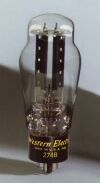
Octal Mojo guitar amp (DIY)
The concept - or how it came to life
|
|
The concept - or how it came to life(by Tom Schlangen)The first ideaSomewhat tired of tube DIY HiFi amps, some time in June 2006 I had the idea to build a small guitar amp for a change.
Getting help(ed)Not knowing much about guitar amps - which, as I soon discovered, is entirely different from designing HiFi gear - I asked Paul Stanley, another regular at The G33k Zone, who instantly offered his help, knowledge and practical advice. Soon, the conversation done by Email almost "exploded", reviewing and discussing existing designs, but also leading to new ideas, both practical and sometimes not so practical, meaning "over the top" for a first time tubed guitar amp project.
Confusion and catharsisWhile the discussion and experiments meandered along, they always had a fixed point they came back to more or less regularly: A very small and compact combo amp like the Fender "Champ" models. But it would have been too easy just to copy this highly successful and long-running design of Leo Fender. The projected amp should be a bit more interesting and distiguishing than just another slavish copy.
So, we were looking for modifications that actually would make some sense, without making things more complicated, especially the
actual usage and control of the amp by someone who wants to focus on playing instead of merely
turning knobs all the time
How much power is enough power?During the experiments it showed that the original Champ circuit output stage (6V6 beam power tube, giving about 5 Watts output power) actually was terribly loud at home, using a small impromptu "208"-type cabinet (two old 8" fullrange speakers, probably from a largish German tubed table top radio of early stereo vintage). No wonder the idea of reducing the output power came up quite early. Soon it showed that even the raw power of only 3 Watts out of a tiny seven-pin EL95/6DL5 pentode used as an output stage still was too much at home or for practice, when wanting a nice tube sound at a moderate volume that would be compatible to the Significant Other and the cats. Now, triode-strapping a 6V6 beam power tube would give only about 1 Watt - but why using an "oversized" beam power tube and strapping it as a triode, when about the same output power could be gained by using real triodes out of the "small signal" category already? Thus the idea was born to design an all-triode based circuit.
Real triodes, octal stylePersonally, I tend to prefer the old fat octal small signal triodes like 6SL7 and 6SN7 before their more modern noval brothers like ECC83/12AX7 and ECC82/12AU7. Besides this, almost every tube amp uses the noval family line of tubes. So I decided to use 6SL7 instead of ECC83 in a frontend circuit pretty much like late Fender Champs, and to use an 6SN7 twin triode with paralleled sections as a flea-power output stage. To find out if my subjective preferences of old octal triodes were justified in a small guitar amp, a 6SL7 shootout was done, also featuring some fancy noval TFK ECC83 and General Electric MIL-spec JAN 5751 tubes just to maintain parity and objectivity. The whole process was supervised by neutral observers (my cats). Yeah, you are right with your assumptions about the outcome of this highly scientific and most demanding test.
Mr. Fender didnīt leave much to improve uponSome further experiments quickly showed that only few other modifications to the original Champ circuit would make additional sense somehow:
The first two mods made it into the final version out of quite obvious reasons, but the idea of an additional master volume pot was dropped because:
The decision was rather easy, since the designers of this amp are excellent guitarists, of course
A simple thing sometimes is hard to nameAt this point, we had a "Fender Champ-like frontend with paralleled single ended triode finals, all class A and using octals, which also features a gain booster switch". If you told a dude this, as an answer to "hey, whats that?" when noticing this little amp, he probably would yawn and fall asleep until we reach the end of that lenghty explanation (you ARE still awake reading this stuff? No? Point made.)
Octal Mojo!Definitely a name more to the point was needed. Now, since it was all-octal and produces plenty ammounts of mojo, it was decided to name it "Octal Mojo", because thatīs what it is and delivers.
Can only a billionaire afford a custom amp of this quality?During the design process, the side-question arose if an amp of this quality can be done for less than, say, a hundred Euros, given you have sufficient and suitable equipment at hand to build the cabinet and chassis on your own and donīt count the value of the workmanship. Yes, it is doable for that money, at least when using particle board for the cabinet.
Honour to whom it is dueIīd like to thank Paul Stanley for all his advice, help and patience in our discussion, and most of all for actually building the "Octal Mojo" amp of course, which became a showcase of his excellent craftsmanship and understanding of the real requirements for a small, but good guitar amp. This project never would have been come to a happy ending without him!
Also, I would like to thank Gregg "The Geek" van der Sluys, SysOp of The G33k Zone
for connecting similar-minded people interested in tube stuff all around the world by his BBS, and allowing to use those tube-smileys
|